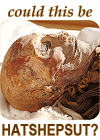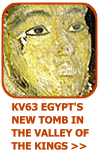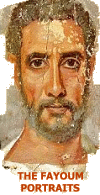|
|
|

Topics in this section: egyptology-how it all began | great discoveries | great egyptologists | rosetta stone
Historical information, not material gain 1914-1945
With the appointment in 1914 of a new Director General of the Egyptian Antiquities Service, Pierre Lacau, the days of the "archaeological free-for-all" were finally drawing to a close. Egyptologists and the Egyptian authorities would clash over the ownership of finds, and the rights of the excavators to work as they saw fit. The "equal division of finds" policy was now no longer tolerated by the authorities, and archaeologists gradually had to accept that they were now excavating for historical facts and information, and not purely for material gain.
If you use the hyperlinks in the list below, you may sometimes need to use your "back" button on your browser to return to this page.
| YEAR |
MAJOR FINDS |
EXCAVATION AND DISCOVERY |
AREA |
| 1915 |
Zenon Archive. Many thousands of Ptolemaic documents: letters, petitions, and accounts written in Greek spanning the period 260-240 BC. A wonderful picture of life in Egypt at this time. |
Egyptian farmers |
Darb el-Gerza, on the site of ancient Philadelphia in the Faiyum. |
| 1916-1920 |
Nubian pyramids and tombs of the 25th Dynasty (Saite Period). |
George A Reisner excavating tombs at the Nubian pyramids of Nuri and the cemetery of el-Kurru. Some tombs had been robbed, but others had been preserved. |
Cemetries of Nuri and el-Kurru beyond the 6th Cataract, where the Kushite kings of the 25th Dynasty were buried. |
| 1916 |
Tomb of the "Three Princesses", three minor wives of Tuthmosis III. Jewels, head-dresses, wigs, amulets, mirrors, canopic jars. |
Egyptian locals. Following violent rainstorms, water pouring down the rock face was seen to disappear into the cliff base without trace. |
Qabbanat el-Qurud, Thebes. |
| 1920 |
The Models of Meketre. A pristine collection of finely detailed wooden funerary models. A wonderful picture of Egyptian everyday life. |
Harry Burton, Herbert Winlock's site photographer discovered a hidden chamber in the previously robbed tomb. |
Deir el-Bahri, Thebes. |
| 1920 |
The golden Uraeus of Sesostris II. Solid gold cobra inlaid with lapis lazuli, turquoise and carnelian. |
Qufti worker, Hosni Ibrahim, helping to clear the Offering Chamber of the pyramid of Sesostris. |
Pyramid of Sesostri II at el-Lahun. |
| 1922 |
The Tomb of Tutankhamun. Spectacular treasures beyond belief. |
Howard Carter. After several years of fruitless digging, a rock-cut step was discovered on 4th November 1922. |
Valley of the Kings, Thebes. Tomb KV62. |
| 1924-1933 |
Statues and tiles at the Step Pyramid of Djoser. The cult statue of Djoser, and inscribed base of a second statue which also included the name of Imhotep. |
Cecil Firth discovered an underground chamber adorned with tiles. Later, Dows Durham, who had been seconded to Cecil Firth's work by George Reisner's Giza camp, discovered the cult statue. |
The Step Pyramid complex of Djoser, Saqqara. |
| 1925 |
The Amarna statues: 25 colossal statues of Akhenaten and his queen Nefertiti. |
Henri Chevrier, during the cutting of a drainage ditch at the Temple of Karnak. |
The east of the enclosure wall of the Great Temple of Amun at Karnak, Thebes. |
| 1928 |
The Library of Kenherkhepshef, Scribe of the Tomb to Ramesses II and Seti II. Collection of literary, magical and medical papyri. |
Bernard Bruyère, director of the French excavations at Deir el-Medina, village of the workmen. |
Deir el-Medina, Thebes. |
| 1931 |
Tutankhamun's Colossi. Two giant statues of painted quartzite. |
Chicago Oriental Institute team. |
The mortuary temple prepared for Ay but used by Horemheb at Medinat Habu, Western Thebes. |
| 1937 |
The Unas Causeway, linking the mortuary temple with the Pyramid of Unas. Decorated with fine artistic scenes in raised relief. |
Selim Hassan. |
The Pyramid complex of Unas, Saqqara. |
| 1939-1940 |
Royal tombs at Tanis, treasures from the Third Intermediate Period. |
Pierre Montet, excavating the Delta city of Tanis. |
Temple of Anta at Tanis in the Delta. |
| 1939 |
Amarna reliefs from Hermopolis. Blocks decorated with reliefs and the names of Aten, Akhenaten and Nefertiti. |
Günther Roeder excavating at Hermopolis discovered the blocks which had been quarried from el-Amarna. |
El-Ashmunein, ancient Hermopolis Magna, close to modern Mallawi. |
A new era of exploration: after 1945
With the tightening of antiquities laws, the Second World War, and revolution in Egypt, excavation in Egypt understandably slowed. Renewed international involved came with the building of the Russian Dam in 1960. As a result of the necessary change of emphasis, the number of spectacular finds may have been reduced somewhat, but the discoveries by chance are still continuing today.
| YEAR |
MAJOR FINDS |
EXCAVATION AND DISCOVERY |
AREA |
| 1952 |
The lost pyramid of Sekhemkhet, the substructure of a step pyramid. The underground chambers contained hundreds of funerary vessels, and some gold treasures. |
Muhammed Zakaria Goneim, Keeper of the Saqqara Necropolis. First discovered a section of the enclosure wall, then the first "step" of the pyramid. |
Located next to the Step Pyramid complex of Djoser at Saqqara. |
| 1954 |
Intact boat pits at the Great Pyramid of Khufu, Giza. |
Kamal el-Mallakh, an inspector with the Antiquities Service. |
South side of Khufu's Great Pyramid at Giza. |
| 1960's |
Hoard of Middle Kingdom bronze statues. |
Circumstances surrounding this discovery are unknown. |
Pyramid complex of Amenemhet III at Hawara in the Faiyum. |
| 1964-1971 |
The Animal Necropolis. Extensive catacombs containing mummified ibis, cows, baboons, falcons, rams, cats and dogs. |
Walter Bryan Emery, Edwards Professor of Egyptology, University College London. |
Early Dynastic Necropolis at Saqqara. |
| 1974 |
The unfinished pyramid of Raneferef. Major finds from the unfinished complex include sculptures of the king and a hoard of papyri. |
Miroslav Verner, of the Czech team from the Charles University, Prague. |
Pyramid complex of Raneferef at Abusir. |
| 1975 |
New Kingdom tombs at Saqqara, the lost tomb of Horemheb. |
Geoffrey T Martin |
Saqqara. |
| 1987 |
Tomb of the sons of Ramesses II. Finds include sarcophagi, coffins, canopic jars, jewellery and pottery. |
Relocated by Kent R Weeks. Partially opened in 1825 by James Burton, and in 1902 by Howard Carter. The entrance was then lost to sight. |
Valley of the Kings, Thebes. Tomb KV5. |
| 1989 |
The Luxor Statue Cache. Over 25 statues buried beneath the Luxor Temple during the Roman Period in the late 3rd century BC. |
Mohammed el-Saghir. Discovered during routine maintenance cleaning operations by the Luxor Antiquities Inspectorate. |
Beneath the Solar Court of Amenhotep III at the Luxor Temple, Thebes. |
| 1990 |
Tombs of the Pyramid Builders at Giza, the worker's tombs. |
Zahi Hawass, Undersecretary of State for the Giza plateau. |
South of the Great Sphinx of Giza. |
| 1994 |
Underwater Alexandria. Architectural elements, statuary, sphinxes, Greek and Roman shipwrecks. |
Jean Yves-Empereur and Frank Goddio. |
Beneath the harbour, and the Qait Bey site, Alexandria. |
| 1996 |
Valley of the Golden Mummies. Cemetery in Bawit, containing upwards of 10,000 Greco-Roman mummies. |
Zahi Hawass excavating in the Western Desert. Discovery announced 1999 to avoid plunder of the tombs. |
Bawit in the Bahariya Oasis, the Western Desert. |
| 2006 |
In February 2006 another ancient Egpytian tomb was found a mere 50 feet from where Tutunkhamun's tomb was discovered, its discovery was entirely unexpected and sent shockwaves around the scientific and archaeological world. |
An international team of archaeologists were doing routine excavation work when they discovered what seemed to be a man-made shaft. A small chamber was subsequently unearthed and found to contain five wooden coffins. |
Tomb KV63 in the Valley of the Kings, just 50ft from Tuntankhamun's tomb. |
|
|
|








